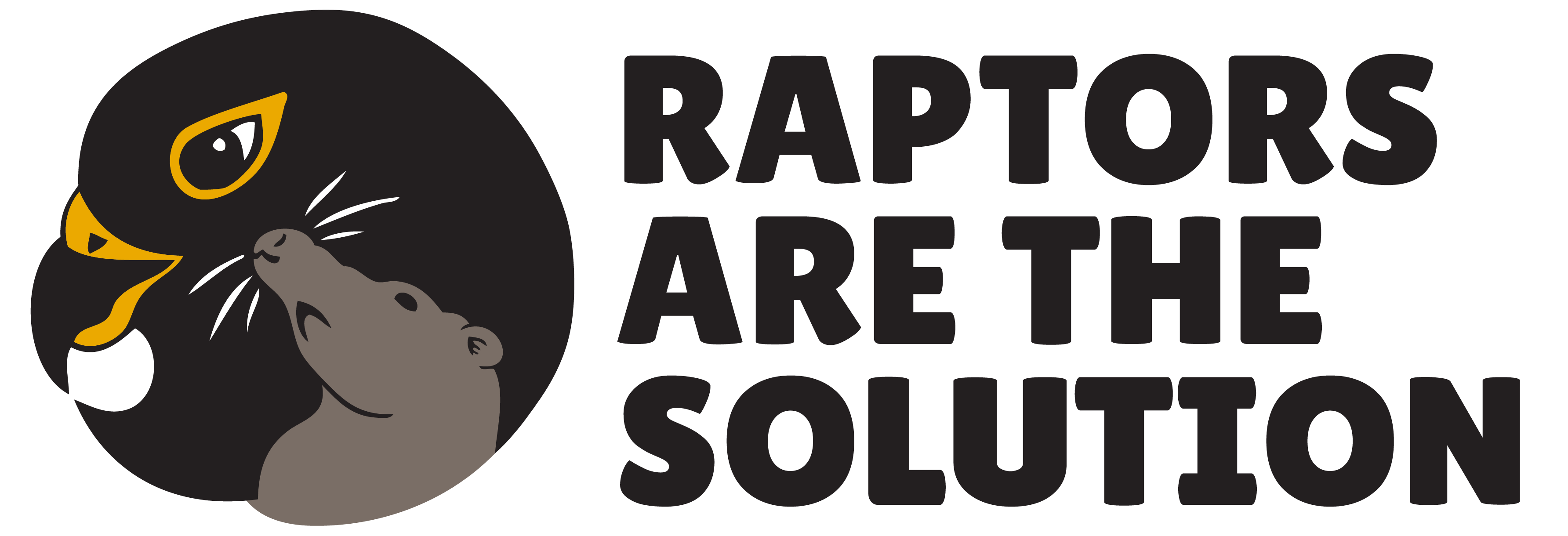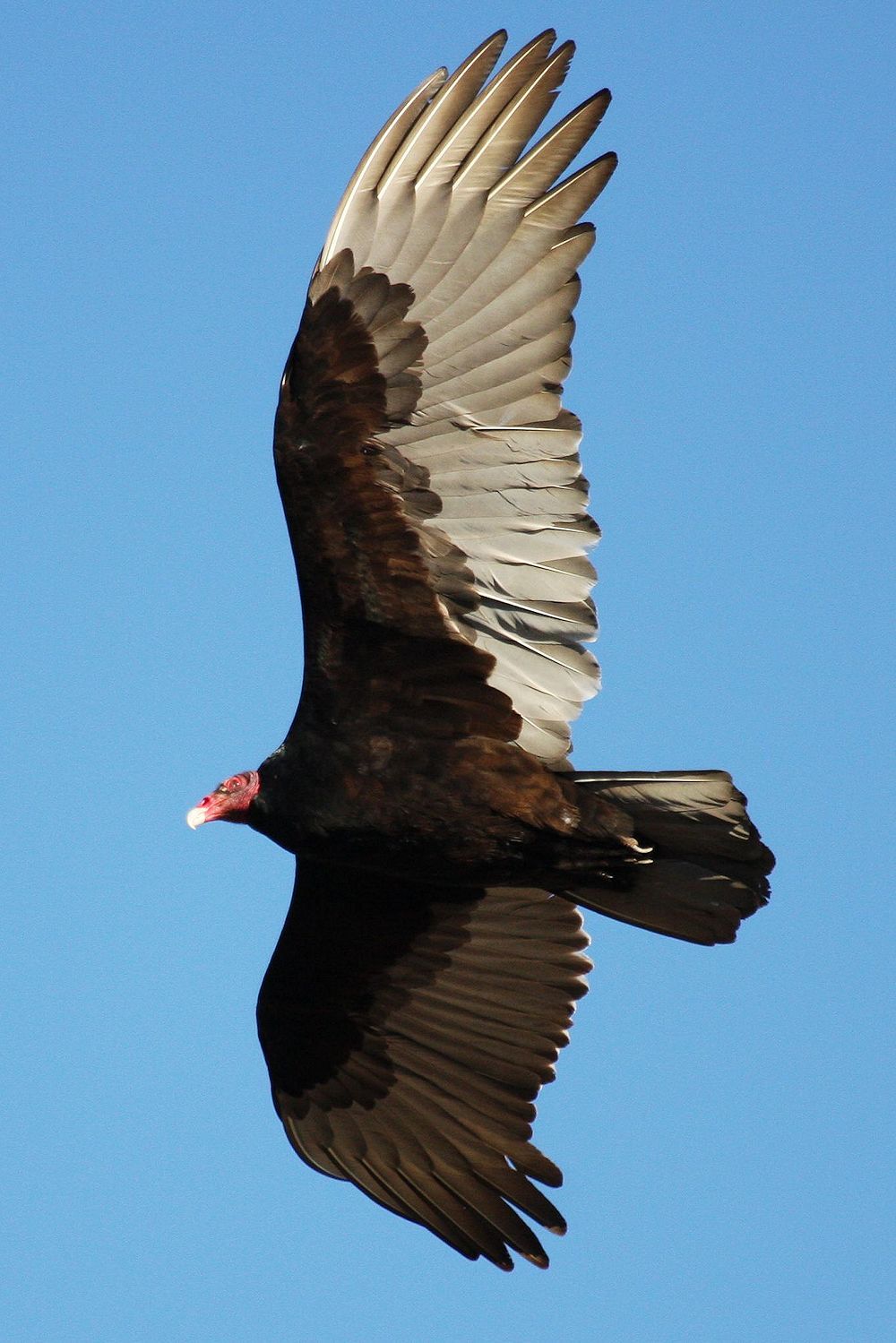(full article from RATS Tales Fall 2015)
Look up in the sky and see if you can find a large black bird that has upturned wings and is rocking gently from side-to-side—called a dihedral. The owner of those giant six-foot wings is a Turkey Vulture (Cathartes aura). I am a fan of the Turkey Vulture and find them to be beautiful, but I know not everyone feels that way. I consider it my personal mission to help people appreciate them, if not for their beauty, then for their adaptations and the important services they provide us.
Does anyone remember Golden Books from childhood? There were Golden Books on just about any subject, but many were, and are, about nature and science. When first published, these books sold for only 25 cents. Since that time billions have been sold worldwide. My copy is marked $2.50. I’m guessing that the series called “Nature’s Sanitation Corps” wasn’t a big seller! This series is described as “a series of books about those creatures that render a useful service in maintaining an ecological balance in nature. Some of the creatures have been maligned as being unattractive and a nuisance, even as they participated in nature’s scheme of interdependence.” Included are The Night in Crusty Armor, Nature’s Carpet Sweeper, The Laughing Garbage Disposal, Nature’s Smallest Gravedigger, Nature’s Assistant, and Nature’s Flying Janitor—the last being our wonderful Turkey Vultures (I will let the reader ponder who the other titles refer to). It would take a lot more space than this to elaborate on all the wonderful adaptations of Turkey Vultures (TVs), so we’ll just focus on the two most easily seen and appreciated.
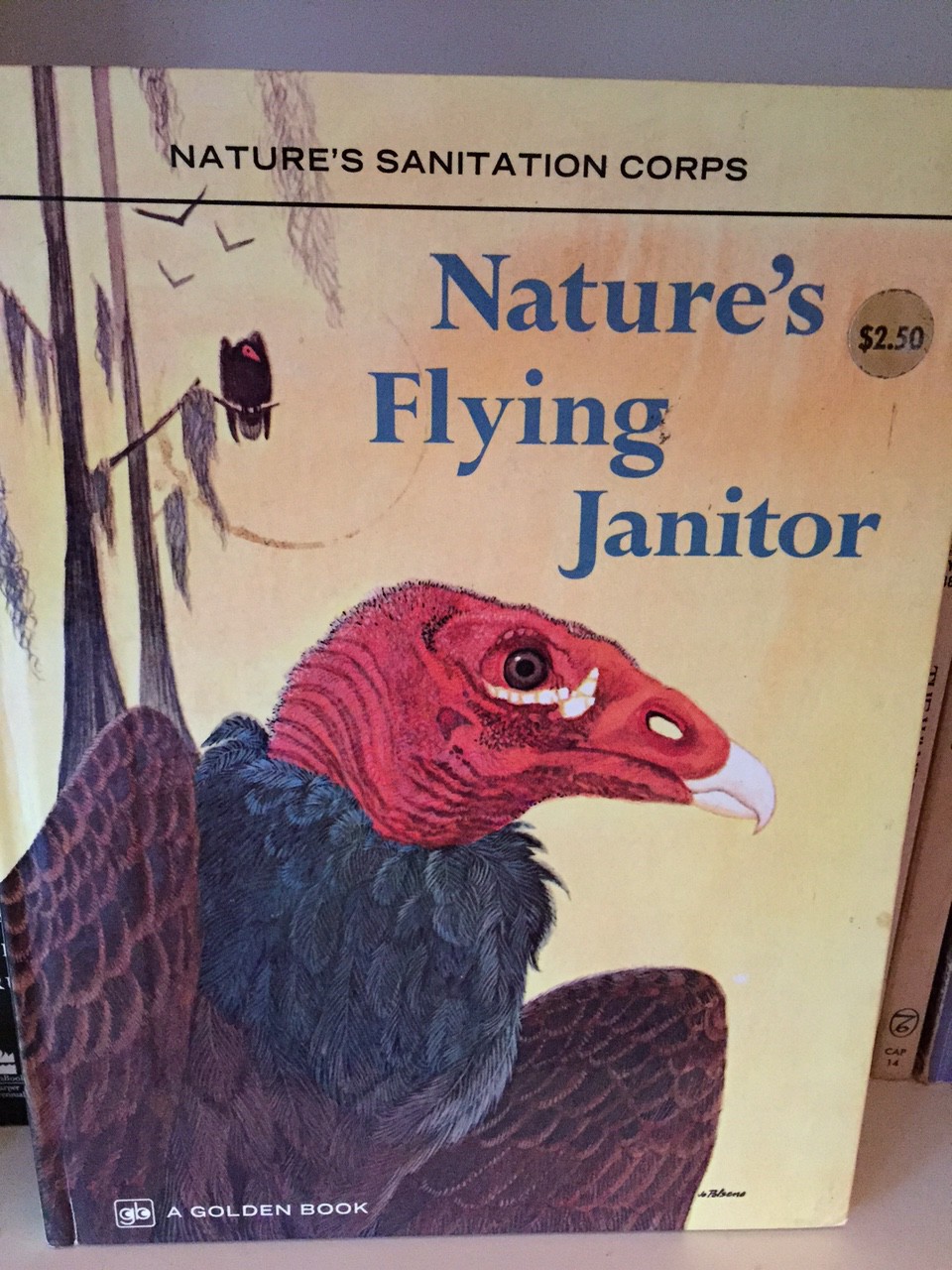
The first most amazing thing about TVs is their ability to fly around all day, while conserving most of their energy. They need this skill because they don’t find food every day and flying takes tremendous resources. So TV’s are master surfers of invisible “waves” in the sky, also known as thermals. When the earth is warm, columns of warm air spiral up into the sky, and birds can use them to rise up higher and higher to their preferred cruising altitude. You’ve probably seen raptors and vultures seeming to circle around way up high. They are forming a “kettle” and are riding that unseen spiral of warm air. This allows the Turkey Vulture to use very little energy as he sends the entire day looking and smelling for carcasses. At night they roost in trees, often with other vultures, and they can conserve energy by going into a mild torpor where their systems slow down. In the morning, they wait for the sun to warm the earth, and are often seen perched in trees, or on fence posts and the like, with wings spread out. If you could get up close to them at this time, you would see that they are not just black. Their feathers glisten with iridescent blues, golds, greens and purples.
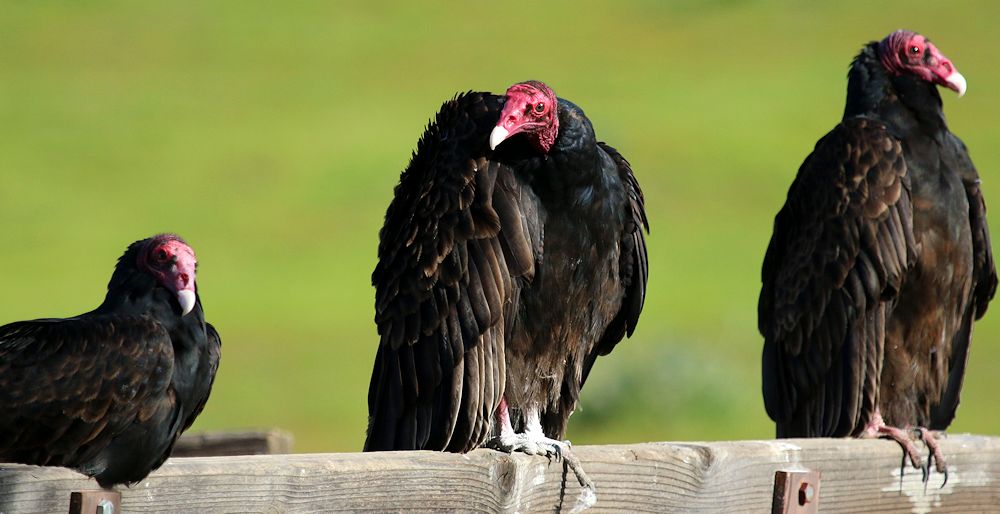 Now that your local TV is warmed up and ready to soar, off she flies, using her great eyesight, and giant nostrils, to find food. TVs live in social orders, so they are curious animals and watch each other for signs of a buffet below. This is where they truly benefit humanity. When creatures die and begin to decay, lots of organisms take over. Some can spread diseases and harm humans and other animals. But the Turkey Vulture has amazing gut juices that neutralize dangerous pathogens like salmonella and botulism. Without Turkey Vultures, we could all be knee deep in rotting, disease-spreading carcasses. Let us all give thanks for these beautiful, important members of Nature’s Sanitation Corps! My favorite page in the book, is the last page “Who knows…someday there may even be a stamp in my honor.”
Now that your local TV is warmed up and ready to soar, off she flies, using her great eyesight, and giant nostrils, to find food. TVs live in social orders, so they are curious animals and watch each other for signs of a buffet below. This is where they truly benefit humanity. When creatures die and begin to decay, lots of organisms take over. Some can spread diseases and harm humans and other animals. But the Turkey Vulture has amazing gut juices that neutralize dangerous pathogens like salmonella and botulism. Without Turkey Vultures, we could all be knee deep in rotting, disease-spreading carcasses. Let us all give thanks for these beautiful, important members of Nature’s Sanitation Corps! My favorite page in the book, is the last page “Who knows…someday there may even be a stamp in my honor.”
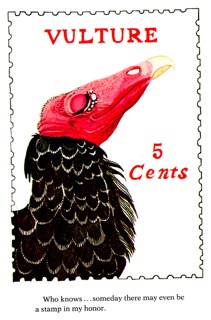 One caveat: because of what they eat, and in spite of their superpower digestive juices, TVs often are poisoned by rodenticides inside dead animals, as well as other household or industrial poisons that end up outdoors. In fact, over the past year or so, a number of comatose and seemingly dead vultures have been delivered to WildCare, a Bay Area wildlife hospital. These birds had ingested a chemical that is used by veterinarians, and also ranchers, to humanely euthanize sick and injured animals, including livestock. It is illegal to just leave such remains out in the open, but somewhere, somehow, that seems to be happening, and Turkey Vultures are paying the price. Let’s hope whoever is behind this terrible practice will be caught or simply do the right thing and stop. Turkey Vultures have an inherent right to exist, outside of our appreciation of their beauty and the vital services they provide us with.
One caveat: because of what they eat, and in spite of their superpower digestive juices, TVs often are poisoned by rodenticides inside dead animals, as well as other household or industrial poisons that end up outdoors. In fact, over the past year or so, a number of comatose and seemingly dead vultures have been delivered to WildCare, a Bay Area wildlife hospital. These birds had ingested a chemical that is used by veterinarians, and also ranchers, to humanely euthanize sick and injured animals, including livestock. It is illegal to just leave such remains out in the open, but somewhere, somehow, that seems to be happening, and Turkey Vultures are paying the price. Let’s hope whoever is behind this terrible practice will be caught or simply do the right thing and stop. Turkey Vultures have an inherent right to exist, outside of our appreciation of their beauty and the vital services they provide us with.
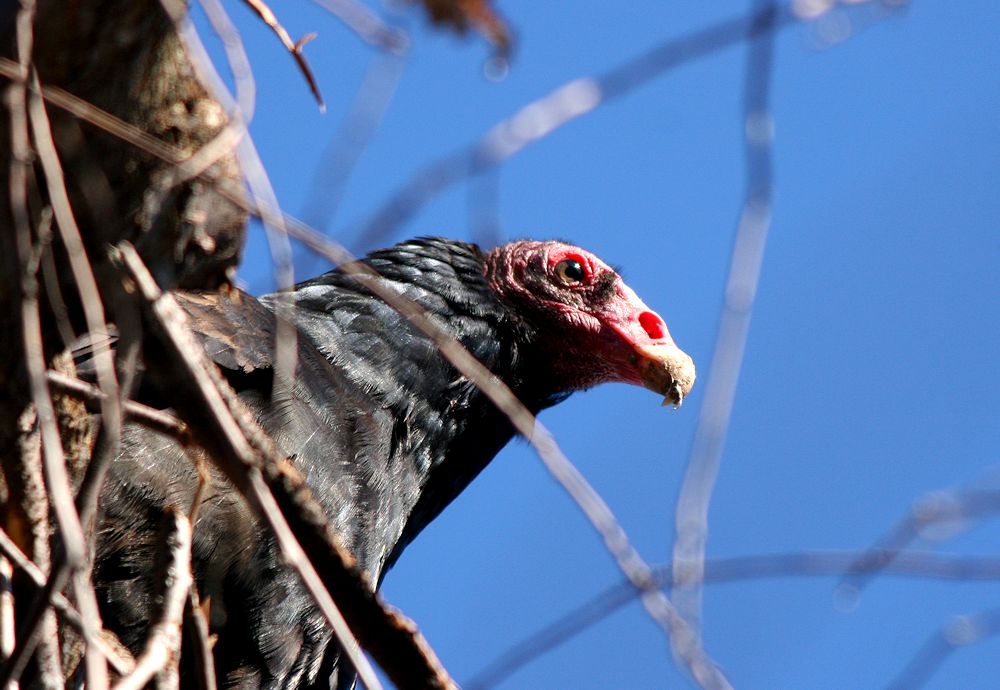 The first sentences of Nature’s Janitor read, “For years I have been portrayed as a villain. In Western movies I am usually seen perched on a cactus or on a dead tree waiting for a lost prospector to give up and die.”
The first sentences of Nature’s Janitor read, “For years I have been portrayed as a villain. In Western movies I am usually seen perched on a cactus or on a dead tree waiting for a lost prospector to give up and die.”
I take it personally when TV’s are portrayed in movies, Halloween decorations and the like as sinister, scary looking birds, just dying to eat you. Nothing could be further from the truth. They are actually quite shy, as far as interacting with humans goes. They are afraid of us, and we have no reason to be afraid of them. So next time you are out and about, if a Turkey Vulture seems to be flying very close above you, and maybe checking you out, just look alive and you have nothing to worry about! If you still feel worried, just say as loudly as possible, in your best Monty Python accent: “I’m not dead yet!” — Maggie Rufo volunteers for RATS, The Hungry Owl Project, and WildCare, where she cares for Vladimir, the center’s non-releasable, educational, 30-year old Turkey Vulture. All Turkey Vulture photos by Dave Harper.
